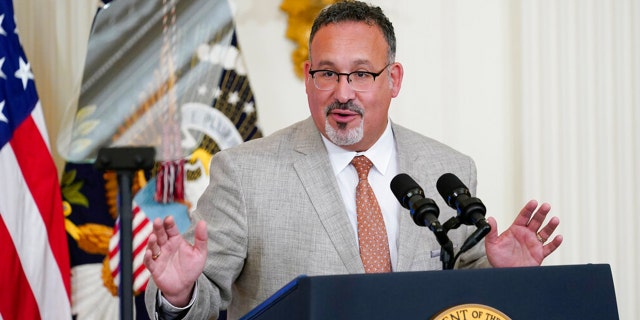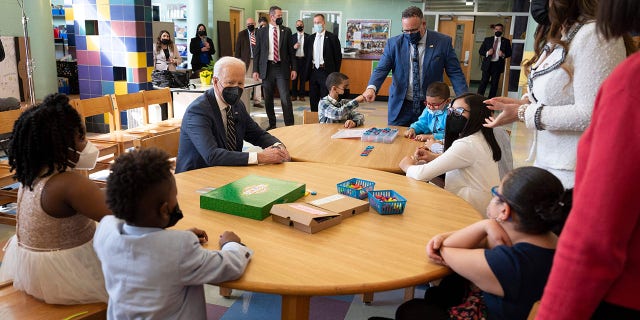The Biden administration wants to make up the nationwide decline in math and reading skills that U.S. students suffered during the COVID pandemic by spending billions of dollars on programs that advance concepts like “equity” and “culturally relevant” learning that are “linguistically responsive.”
The Nation’s Report Card said Monday that math and reading scores fell in most states for fourth and eighth graders during the pandemic, which led policymakers to shutter schools for months. The report said those closures led to the largest drops ever recorded for math and noted that math scores fell in every state.
White House press secretary Karine Jean-Pierre said those results are “unacceptable,” and the Department of Education released a Learning Acceleration Guide that advises local school districts across the country on how they can “address learning loss and academic recovery.”
That six-page guide is infused with the Biden administration’s diversity, equity, inclusion and accessibility (DEIA) agenda, and begins by saying “underserved” students are the most in need of help as schools work to put students back on track.
US MATH, READING TEST SCORES PLUNGE FOR STUDENTS ACROSS COUNTRY FOLLOWING COVID-19 PANDEMIC
President Joe Biden’s Department of Education released a plan Monday to recover from lost learning during the COVID pandemic.
(Olivier Douliery/AFP via Getty Images)
“While COVID-19 has touched all students, it has deepened pre-existing inequities facing students of color, students from low-income backgrounds, multilingual learners, students with disabilities, LGBTQI+ students, students experiencing homelessness, and other underserved students,” the guide states.
It then proposes six main strategies for schools, all of which lean on using billions of dollars from the 2021 American Rescue Plan, and most of which push Biden’s DEIA agenda.
The guide first proposes that schools provide students with “tailored learning acceleration opportunities,” which primarily means giving teachers and staff “high-quality and ongoing professional development and coaching.” It suggests using school vacation time to support students with the “greatest need,” and calls for using instructional materials that are “culturally relevant.”
It calls for “high-quality and effective tutoring” by teachers or others who are qualified, and the use of an “evidence-based curriculum” and “practices that support positive learning experiences.”
TEACHERS’ UNION HEAD SILENT OVER LATEST US TEST SCORES SHOWING TROUBLING DECLINE IN MATH, READING

Education Secretary Miguel Cardona said Monday the drop in reading and math skills is “unacceptable,” and released a plan to use federal funding to restore student performance.
(AP Photo/Susan Walsh, File)
The guide suggests personalized instruction practices that “support teaching and learning progressions in culturally and linguistically responsive ways.”
It calls on schools to integrate the “social, emotional and academic needs” of all students by designing “equitable learning environments” that focus on “fostering belonging, creating rigorous and engaging and culturally responsible learning environments.”
The guide calls on school districts to provide support from preschool to postsecondary education by providing rigorous instructional materials that are “culturally and linguistically relevant.”
Finally, it asks school districts to create “out-of-school” learning opportunities that it said can lead to “positive social, emotional, and academic outcomes.” It said these opportunities should be centered on small groups of students and work with community partners that let students work with “staff who may be more racially, culturally, and linguistically diverse.”
The guide offered several examples of how school districts are already using American Rescue Plan funds to create these programs.
EXPERTS REACT TO US MATH, READING SCORES DIPPING FOR STUDENTS AFTER COVID-19: ‘DISMAL’

President Biden’s administration is touting access to billions of dollars in federal funding to help schools catch up after COVID.
(Jim Watson/AFP via Getty Images)
One of these is Rhode Island’s Learning, Equity and Accelerated Pathways District Support Program Task Force, which is using tutoring to “meet the diverse needs of students.”
Another is a plan from the Oregon Department of Education that uses American Rescue Plan funds to ensure all education agencies have an “equity-centered plan to invest in drop-out prevention” and other programs.
CLICK HERE TO GET THE FOX NEWS APP
The Department of Education said the American Rescue Plan provided $130 billion to schools to help them reopen in the wake of the pandemic and provide “evidence-based programs” to support accelerated learning.
“Independent analysis shows that school districts nationwide plan to spend more than $27 billion on academic recovery, including more than $6 billion on summer learning and after-school programs and $3 billion on tutoring and coaching for reading and math; and an additional $30 billion on staffing, including hiring more educators, and providing professional development so that educators know how to best support their students’ recovery,” the department said.
 Milon Shil All About Entertainment, Lander World
Milon Shil All About Entertainment, Lander World